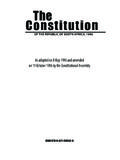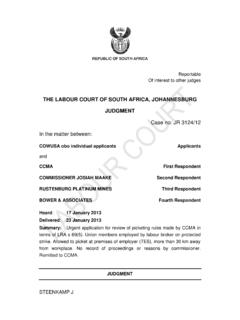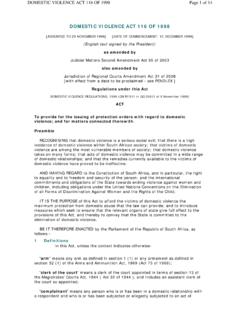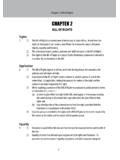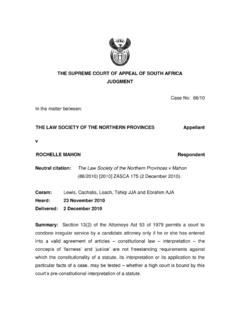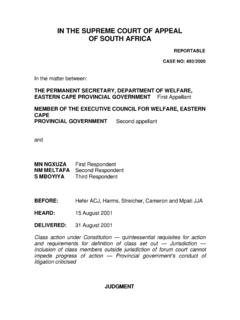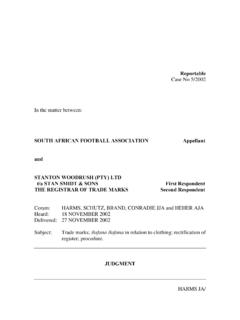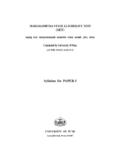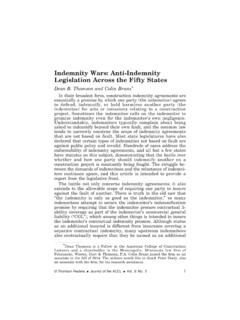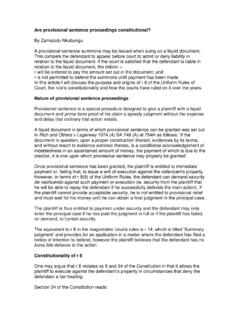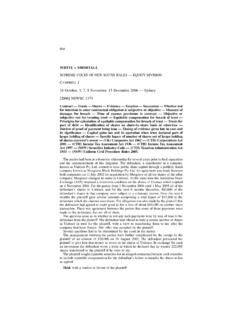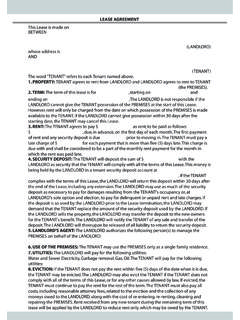Transcription of THE SUPREME COURT OF APPEAL OF SOUTH AFRICA
1 THE SUPREME COURT OF APPEAL OF SOUTH AFRICA . JUDGMENT. Case No: 611/2010. In the matter between: NTOMBIZODWA YVONNE MAPHANGO. (NOW MGIDLANA) AND 17 OTHERS APPELLANTS. v AENGUS LIFESTYLE PROPERTIES. (PTY) LTD RESPONDENT. Neutral citation: Maphango v Aengus Lifestyle Properties (611/2010) [2011]. ZASCA 100 (1 June 2011). Coram: Brand, Lewis, Cachalia, Shongwe JJA and Plasket AJA. Heard: 17 May 2011. Delivered: 01 JUNE 2011. Summary: Termination of lease agreements tacit term contended for that landlord will not employ termination clause in order to renegotiate new leases at higher rental found not to have been established reliance on s 26(1) of the Constitution and other considerations of public policy unsuccessful 2. _____. ORDER. _____. On APPEAL from: SOUTH Gauteng High COURT (Johannesburg) (Van der Riet AJ.)
2 Sitting as COURT of first instance). The APPEAL is dismissed. _____. JUDGMENT. _____. BRAND JA (LEWIS, CACHALIA, SHONGWE JJA and PLASKET AJA): [1] The 18 appellants are lessees of flats in a ten storey building known as Lowliebenhof, in Braamfontein, Johannesburg. The respondent is the owner of the building. Proceedings started when the respondent brought an application in the SOUTH Gauteng High COURT , Johannesburg, for the eviction of the appellants and their families from the flats on the basis that their leases had been duly terminated by notice on its behalf. The appellants opposed the application, essentially on two grounds. First, that the respondent's purported termination of the leases was invalid. Second, that, even if the leases were validly terminated, it would not be just and equitable to evict them from the flats.
3 For the second ground they relied on the provisions of s 4(6) of the Prevention of Illegal Eviction from and Unlawful Occupation of Land Act 19 of 1998, that generally became known as PIE. [2] When the application came before Van der Riet AJ in the COURT a quo, the respondent conceded that the leases of two of the appellants, Ms Siguca and Ms Masemola had not been validly terminated. With regard to the sixteen other leases involved, Van der Riet AJ upheld the respondent's contention that the 3. termination was valid. He further held, in respect of nine of the appellants, that there were no grounds of justice and equity, as contemplated in s 4(6) of PIE, that would justify the refusal of their eviction. These nine appellants were therefore evicted. As to the other seven appellants, he concluded that an eviction order would render them homeless and would thus not be just and equitable as contemplated by s 4(6) of PIE.
4 At the behest of these appellants, he therefore postponed the application for their eviction for three months so as to afford them the opportunity to join the City of Johannesburg as a party to the proceedings and to obtain a report from the latter, setting out what steps it could take to provide them with alternative accommodation. As to the costs of the application, Van der Riet AJ decided that since the matter involved constitutional issues, the parties should pay their own costs. [3] The APPEAL against the judgment of Van der Riet AJ is with his leave. In essence it is aimed at two findings in the judgment. First, that the leases were validly terminated. Second, that Ms Siguca and Ms Masemola should pay their own costs. Termination of the lease agreement [4] I start with the issues surrounding the termination of the leases.
5 The respondent purchased the property in 2007, but only became the owner in May 2009, shortly before the eviction applications were launched. It was not a party to any of the leases. They were concluded over the years between the different appellants, as lessees, and whoever happened to be the respondent's predecessor as owner of the building at the time, as lessor. However, by operation of the common law principle of huur gaat voor koop, the respondent became the successor to all rights and obligations deriving from these lease agreements, when it became the owner of the building. [5] The appellants entered into four different pro forma lease agreements that were identified with reference to the name of the lessor at the time, as the 4. Ithemba agreement, the Union agreement, the Artisan agreement and the Eagle Creek agreement.
6 For reasons that will soon become apparent, the appellants emphasised those terms of the four agreements that deal with increases in the stipulated rental while the respondent's focus was directed at the period of the lease for which the different agreements provide. [6] As to increases in the stipulated rental, three of the agreements expressly limit the increment at which the stipulated rent can be increased annually. The Ithemba agreement permits an increase of 10 per cent, together with an amount equal to any increase in rates, taxes and other stipulated expenses payable by the lessor in respect of the building, distributed pro rata between the tenants occupying the property. In the Union agreement, the annual escalation is 15 per cent, while the Artisan agreement limits the increment to the lessee's pro rata share of any increase in rates and taxes payable by the lessor.
7 The Eagle Creek agreement is the exception. It does not specifically impose a limitation on the increase of rental, but it is common cause that in this case any increase must be reasonable (see s 5(6)(c) of the Rental Housing Act 50 of 1999). Finally, the Ithemba agreements provide that in the event of some legislative provisions affecting the rental, the respondent cannot increase the rent without first approaching the competent authority for leave to do so. [7] As to termination of the leases, each of the agreements provides for an initial fixed period. In the Ithemba agreement, for example, it is 12 months. After the initial period, each agreement is automatically renewed indefinitely. Three of the agreements contain an express provision entitling both parties to terminate the agreement on written notice to the other, though the periods of notice required are of different duration.
8 The Artisan agreement does not have an express term providing for termination by notice. But it is not in issue that in terms of the residual rules of the common law, this agreement is also terminable by either party after the initial period, on reasonable notice to the other (see eg A. J Kerr The Law of Sale and Lease 3 ed (2004) at 488; Francois du Bois (ed). 5. Wille's Principles of SOUTH African Law 9 ed (2007) at 918 para 9(1) and the authorities there cited.) With regard to termination, the Ithemba agreement again contains a provision which is not to be found in the other agreements. It is to the effect that, if the lease is supported by a Department of Housing subsidy, termination shall be at the discretion of the lessee. As it turned out, the only two leases that were supported by a Departmental subsidy were those of Ms Siguca and Ms Masemola.
9 That is why the respondent conceded that their leases could not be terminated on notice by the respondent. [8] It is common cause that in respect of all the leases the initial fixed period had lapsed prior to the notices of termination, to which I now turn. From about September 2008, the respondent gave written notice of termination of the leases to each of the appellants. The notices called upon them to vacate their flats on different dates during the period from November 2008 to March 2009. The notices also informed the appellants that if they wished to stay on in their flats beyond the stipulated dates, they would have to enter into new lease agreements at rentals which were between 100 per cent and 150 per cent more than what they were paying at the time. The appellants refused to accept the termination of their agreements.
10 They also said that they could not afford to pay the increased rent. They accordingly remained in occupation and continued to pay the rental amounts that they were paying at the time. [9] The respondent's explanation as to why it gave these notices remained mainly undisputed. According to this explanation, the respondent's business model is to acquire buildings in the Johannesburg CBD that are often derelict, which it then renovates and rents out to tenants. This business model requires it to be able to generate sufficient income from rental in order to service the acquisition and renovation costs of the building. It acquired Lowliebenhof for R11 628 000, which it obtained through bond finance. 6. [10] After acquisition of the building, the respondent spent an amount of over R1 million on renovation and maintenance.

